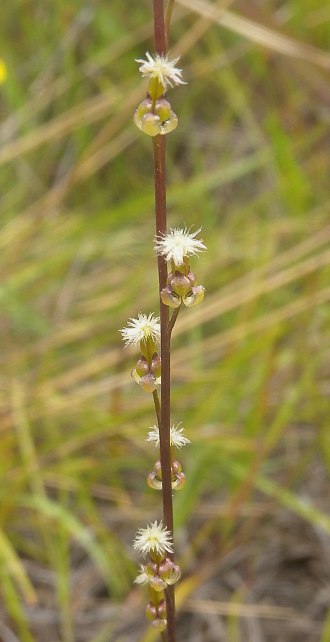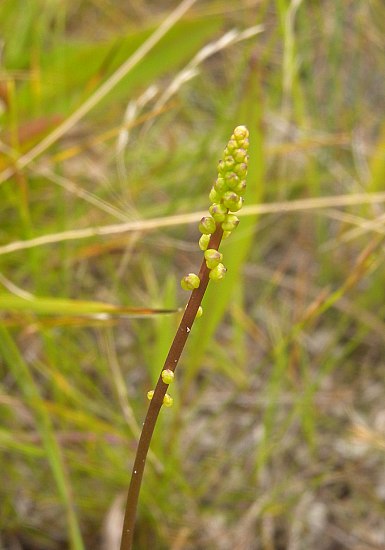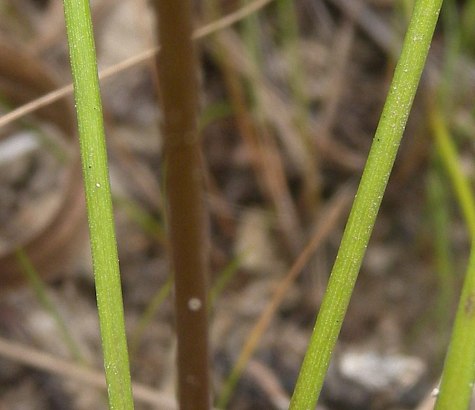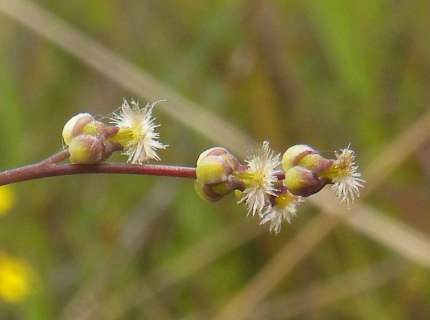
The slender pedicels of the flowers are 2-10 mm. long, ascending to erect, reddish brown, and hairless. The blooming period occurs during the summer and early autumn, lasting about 1-2 months for a large colony of plants. The flowers are cross-pollinated by the wind. Afterwards, the pistils develop into 3-celled fruits (schizocarps) about 7-9 mm. long and 1 mm. across. These fruits are narrowly oblongoid-oblanceoloid in shape and 3-angled; they are initially green, but later become brown. At maturity, these fruits divide longitudinally into 3 narrow sections, beginning at the bottom. The central axis of each fruit is 3-winged; there are 3 seeds per fruit. The seeds are similar in appearance to their fruits, but a little shorter and more slender. The root system consists of a whitish crown with fibrous roots.

Cultivation: The preference is full sun, wet conditions, and a barren calcareous soil containing an abundance of sand or gravel. This plant is intolerant of competition from other ground vegetation. It is quite cold-hardy.

Range & Habitat: The native Slender Arrowgrass (Triglochin palustris) is rare in Illinois, where it is state-listed as 'endangered.' It is found in the NE section of the state and 2 counties toward the center of the state (see Distribution Map). Illinois lies along the southern range-limit of this species. In the United States, Slender Arrowgrass occurs in the New England region, Great Lakes area, Northern Plains, and scattered areas of the western states. It also occurs in Canada, Eurasia, and New Zealand. In Illinois, habitats consist primarily of fens, calcareous gravelly seeps, marl flats, and calcareous sandy pannes near Lake Michigan. This very conservative plant is restricted to high quality natural areas within the state.

Faunal Associations: Floral-faunal relationships of this plant in Illinois are not known. Further to the north in Canada and Alaska, the foliage and especially the whitish crowns are a preferred source of food for the adults and goslings of several species of geese, including Branta canadensis (Canada Goose), Branta bernicula nigricans (Black Brant Goose), and Chen caerulescens (Lesser Snow Goose). The foliage and crowns of Slender Arrowgrass (Triglochin palustris) are reportedly high in protein and low in fiber (Mulder et al., 1996; Prevett et al., 1985).

The foliage also contains hydrocyanic compounds that can be toxic to sheep and cattle if it is consumed in sufficient quantity. There is some evidence in Europe that the seeds of this plant can cling to the fur of deer and cattle. Thus, these animals can spread the seeds to new areas (Mouissie et al., 2005).
Photographic Location: A gravelly seep in McHenry County, Illinois.

Comments: This plant is not very showy and it is easily overlooked. The only other species of this genus that occurs in Illinois, Sea Arrowgrass (Triglochin maritima), is also very rare within the state and it occurs in similar areas. Sea Arrowgrass is a little larger and stouter than Slender Arrowgrass (Triglochin palustris) overall. Its fruits (schizocarps) have a wider ovoid shape and they divide into 6 sections (6 seeds per fruit), rather than 3 sections. Unlike Slender Arrowgrass, the central axis of its fruit is not winged. The wind-pollinated flowers of these plants are rather odd-looking because their feathery stigmas resemble tufts of hair that are typically found on seeds. An alternative spelling of the scientific name for Slender Arrowgrass is Triglochin palustre, and another common name of this plant is Marsh Arrowgrass.